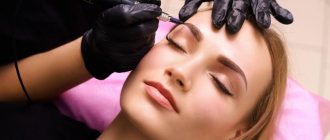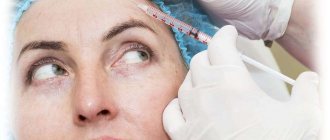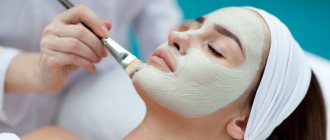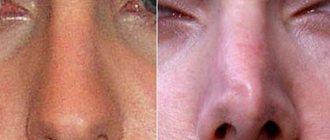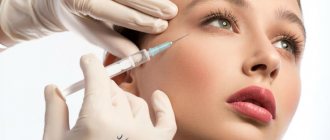How should recovery proceed?
The technology for performing eyelid blepharoplasty has long been well established, so the procedure rarely causes serious adverse reactions and complications. Despite this, it is necessary to pay special attention to the first days after surgery. The quality and speed of rehabilitation depends on them.
The following factors may affect the length of the recovery period:
- patient's age;
- technique and scope of blepharoplasty;
- the thickness of the subcutaneous fat layer (the denser it is, the slower the swelling goes away).
The procedure is performed under local or general anesthesia. If the intervention was minimally invasive (transconjunctival or laser correction), the woman goes home the same day, preferably with an accompanying person. With classic blepharoplasty, the patient remains under medical supervision until the next morning or longer.
On days 4–5, cosmetic sutures are removed from the eyelids (if they are not self-absorbing), and on day 7, antiseptic patches are removed. By this point, most women's bruising and swelling have resolved and they can return to work.
Scarring of the postoperative wound continues for 10–30 days. New connective tissue appears at the site of the incision and after 1.5–2 months only a barely noticeable scar remains.
The first days after blepharoplasty
No matter how well blepharoplasty is performed, it is always accompanied by early side effects. These include bruising, swelling, problems with the incision, and an unattractive appearance.
Seams
Sutures after blepharoplasty are applied only in the case of classical intervention. With transconjunctival access, when the incision is made from the inside of the mucosa, a bandage and mesh bandage are used.
If blepharoplasty was performed through a skin fold and the suture is torn, the wound is re-sutured and an antiseptic sticker is applied. The cause of the complication is incorrect alignment of the wound edges during surgery, severe swelling, mechanical damage, or early removal of surgical sutures.
Dehiscence of sutures is dangerous due to an increased risk of infection and the formation of a rough scar.
Edema
Swelling is considered a completely normal reaction of the body to injury, so it does not cause concern on the first day. If tissue swelling lasts more than a week, this is a complication that needs to be treated.
Avoiding spicy, salty and too hot foods and applying cold to the eye area will help reduce the intensity of swelling.
Scarring
As you know, scar tissue is a fickle thing. It is very difficult to predict or prevent its occurrence. Rough scars, granulomas and cysts form due to an individual predisposition to the formation of keloids or improper suturing of the incision.
Small fibrous seals resolve on their own over time, the rest have to be treated or polished.
Bruises
Hematomas may appear immediately after blepharoplasty or several days later. Many women consider them the most unpleasant complication - indeed, with such “decoration” it is difficult to go to work or to the store.
How long do bruises last? Usually the resorption period lasts up to 3 weeks. With a longer process, the bruises thicken and form persistent infiltrates, which are difficult and take a long time to resolve.
The safest and easiest to treat is subcutaneous hematoma. Despite its frightening appearance, it is easily eliminated with local remedies. Tension and retrobulbar hemorrhages require more active therapy.
Bags under the eyes
One of the goals of blepharoplasty is to remove excess skin and hernias under the eyes. If the surgeon did not try hard enough and did not completely remove the fat layer, sagging skin will still be noticeable, and swelling will make it more pronounced.
Preparation for reconstructive surgery on the face and body
Rapid and successful healing of postoperative wounds must be planned before the start of surgery.
This especially applies to reconstructive operations, in which the surgeon has to make incisions not where they will be least noticeable (as when performing aesthetic operations), but where some kind of defect or scar is already present. It often happens that such a defect is located along the muscle fibers; in this case, muscle activity will interfere with wound healing, especially in cases where it is unfavorable relative to the vector of muscle traction.
In such cases, constant microtrauma will occur, which is caused by displacement of damaged tissue. The inflammatory reaction will be more active and this will lead to the formation of a more noticeable scar. The use of botulinum toxin preparations (Botox, Dysport, Lantox) for injection into the muscles surrounding the wound minimizes repeated displacement of the wound edges and makes the scar less noticeable. In addition, the absence of tissue tension allows the use of thinner suture material, which provides a better cosmetic result.
How to speed up rehabilitation
On average, the recovery period after blepharoplasty lasts 14–30 days and depends on the type of intervention, as well as the individual characteristics of the patient. Various manual and physiotherapeutic procedures, taking medications and applying ointments will help speed up the process.
Do not prescribe treatment yourself under any circumstances. This should be done by the doctor who performed the blepharoplasty. If you have doubts or questions, contact him or go to a dermatologist.
Compliance with the regime, a balanced diet and careful care of the skin of the eyelids will significantly speed up the period of full recovery and reduce the risk of complications.
Medications
The pain that appears after the anesthesia wears off is usually not too pronounced. But if unpleasant sensations become obvious and interfere with life, it is better to stop them.
For this, the following drugs are prescribed:
- Paracetamol;
- Baralgin;
- Nise;
- MOMENT;
- Ketonal.
Decongestant therapy includes taking potassium-sparing diuretics: Hypothiazide, Veroshpiron, Triampur. To prevent infection, the eyelids are treated with antiseptics - Furacilin or Chlorhexidine.
To get rid of colloidal scars, a step-by-step approach is necessary.
First, a corticosteroid drug (Diprospan or Kenalog) is injected into the thickness of the fibrous compaction, making the scar soft and accelerating resorption. It is very important to choose the exact dose and depth of administration.
Then, using a laser, the surface of the skin is smoothed and the scar is “painted” to match the color of the surrounding tissue. In this way, if you do not completely remove the scar, you can significantly reduce it and make it invisible.
Local therapies
External remedies will also help get rid of the unpleasant consequences of blepharoplasty. To combat bruises and swelling at home, ointments and creams are most often used:
- Hydrocortisone;
- Traumeel S;
- Indovazin;
- Lyoton;
- Lokoid.
To reduce itching and speed up wound healing, Blefarogel or Imoferase cream are prescribed.
To prevent the growth of fibrous tissue and form a soft and even scar, use silicone-based ointments: Clearvin, Kelofibraza, Dermatix gel or Contractubex.
Drops will help eliminate dryness, irritation and redness of the eyes:
- Katinorm,
- Innoxa,
- Oksial,
- Artificial tear
- Systane.
Apply the solution to the inner surface of the lower eyelid, pulling it slightly to the side.
Traditional methods are also well suited for tissue restoration, but they can only be used after the wound has completely healed. To reduce swelling, make a compress of raw grated potatoes, and rubbing with ice from chamomile or sage will not only restore attractiveness and shine to the eyes, but will also tighten sagging skin under the eyes, smooth out wrinkles and folds.
Gymnastics for the area around the eyes
Eye exercises are one of the components of the recovery period. Exercises will eliminate swelling in the periorbital area, improve blood circulation, tighten sagging skin and reduce the severity of wrinkles. You can start exercising 36–48 hours after blepharoplasty.
Gymnastics should not cause feelings of pain, fatigue, tension and other unpleasant sensations. A set of exercises should be performed daily, spending 15–20 minutes on it.
Massage after blepharoplasty
Manual and hardware massage activates blood circulation, accelerates the outflow of lymph, restores muscle tone and promotes the removal of waste products from the body. The procedure improves nutrition and healing of injured tissues, eliminates pain in the infraorbital area.
Laser resurfacing
If colloid scars still form after blepharoplasty, you should resort to hardware correction methods. Laser resurfacing is considered to be one of the most reliable and effective ways to get rid of fibrous seals.
The beam evaporates sections of connective tissue layer by layer, gradually smoothing and leveling the surface of the scar. At the treatment site, active synthesis of collagen fibers begins, filling the burned areas and forming a new dermis.
Other physiotherapy
To speed up the healing process and reduce unpleasant symptoms, it is recommended to begin physical therapy already 3-4 days after blepharoplasty. The following procedures have the best restorative effect:
- UHF therapy;
- phonophoresis;
- microcurrents;
- Darsonval.
During exposure to electromagnetic waves, postoperative tissues absorb a huge amount of heat, which significantly accelerates metabolism and creates a rapid regenerative effect. But it is very important to prevent overheating, since the body does not always feel an immediate burn.
Do not forget to inform your doctor about the presence of metal connections under the skin (crowns, bone overlay, jaw joint prosthetics).
Ultrasound treatment gives a good lymphatic drainage effect, improves blood circulation and has an analgesic effect. Microcurrents gently stimulate the dermis and underlying vessels, restore cell activity, improve contraction of facial muscles and eliminate fluid stagnation in the subcutaneous layers.
The Darsonval apparatus has proven itself very well. High-frequency currents soften fibrous tissue, accelerate regeneration and tighten weak skin. The therapeutic course can be carried out both in the clinic and at home.
After the stitches have healed, it is a good idea to carry out mesotherapy. The procedure will reduce the severity of postoperative scars, eliminate skin tightness, and as a pleasant bonus, smooth out wrinkles.
Causes of side effects
If a client deliberately hides the presence of contraindications, ignores the cosmetologist’s recommendations, and does not adhere to restrictions before and after the procedure, the risk of developing blepharoptosis or edema increases.
A cosmetologist may make one of the following mistakes:
- do not take into account the individual structural features of the patient’s facial muscles;
- excessively dilute the drug and administer it in large doses, which will cause increased diffusion of the substance;
- violate the insertion technique;
- choose the wrong injection points;
- It is not possible to find out all the contraindications.
It is much easier to avoid unpleasant side effects than to engage in lengthy and sometimes expensive treatment in the future. That is why it is extremely important to responsibly choose a clinic and a doctor who will inject the drug.
What not to do during the rehabilitation period
So, how to care for the skin of the eyelids after blepharoplasty, what can and cannot be done during this important period?
Basic prohibitions:
- For 5–7 days, do not wash your face and protect your eyelids from water.
- Avoid any activities that dry out the cornea and cause fatigue (reading, working on a computer, watching TV).
- Reduce any physical activity to zero for the first three days after surgery.
- Stop wearing lenses for a week;
- Postpone your visit to the bathhouse, sauna and swimming pool to a later date.
- Don't drink alcohol and stop smoking.
For 3 months after eyelid surgery, try not to sunbathe and wear dark glasses. When going outside, be sure to protect your skin with cream with SPF of at least 30, drink less, and avoid stress and overwork.
Perform various eye manipulations (eyelash extensions, tattooing of the interlash area) only after complete rehabilitation.
If the recovery period is complicated, do not forget to take the recommended medications and visit the physiotherapy room, but if cryodestruction is prescribed, refuse the procedure. Why can't you use liquid nitrogen? The fact is that scars under its influence do not disappear - they only smooth out and spread in breadth, spoiling the appearance of the skin.
Complications after surgery
Complications and side effects after blepharoplasty can not only ruin your appearance, but also undermine your health.
What plastic surgeon patients face:
- lacrimation. The cause is swelling or abnormal scarring;
- diplopia (double vision) in the eyes. The disorder occurs due to swelling, exposure to an anesthetic, or severe hemorrhage;
- chemosis (edema) of the mucous membrane. May appear due to infection, an allergic reaction to irritants, or extensive blepharoplasty;
- ectropion (inversion of the lower eyelid). Occurs infrequently. The cause of the complication may be non-compliance with the surgeon’s instructions or the removal of a large amount of skin. As a result, the eyelids stop closing and an open area of the cornea appears between them;
- dry keratoconjunctivitis. Considered to be an individual patient's response to the intervention;
- retrobulbar hematoma. One of the most severe complications of blepharoplasty. Its symptoms are blurred vision, eye pain, and protruding eyeball.
In some cases, there is numbness of the skin in the infraorbital area, thinning of the eyelashes on the lower and/or upper eyelids, and a slight fever may rise, especially in the first day after the intervention.
And try not to have eyelid blepharoplasty in the summer. During this period, rehabilitation is more difficult, and consequences occur more often.
Aesthetic complications include:
- Eye asymmetry.
- Hypercorrection. It is a surgeon’s mistake and leads to distortion of the palpebral fissure and lagophthalmos.
- Excessive removal of fat during blepharoplasty. Creates a characteristic dip in the intervention area (sunk eye effect).
- Blepharoptosis (drooping of the upper eyelid).
- Round (fish) eye.
- Hyperpigmentation of the skin in the periorbital zone.
Most of these complications require repeated surgical intervention.
Preparing for blepharoplasty
Preparing for surgery with the preliminary administration of Botox, Dysport, Lantox helps prevent many complications that arise during upper eyelid surgery. Most often, patients requiring blepharoplasty have one eyebrow located lower than the other; As a rule, the lowered eyebrow is on the side on which the patient sleeps more often.
There is a risk during surgery of increasing the asymmetry by removing more skin from the side of the lowered brow line. Preliminary injection of Botox, Dysport, Lantox before surgery returns symmetry to the patient’s face and helps the surgeon correctly plan the scope of the operation.
The introduction of drugs containing botulinum toxin A into the “crow’s feet” area before surgery makes it possible to hide the incision line within the bony edge of the orbit. This eliminates the need to correct such facial wrinkles surgically, significantly reduces the amount of intervention and guarantees an effective aesthetic result.
Combining the administration of Botox, Dysport, Lantox with surgery (blepharoplasty) allows you to inject drugs directly into the orbicularis oculi muscles. This method gives longer-term paralysis of these muscles - up to 12 months, much longer than when Botox is administered through the skin. In addition, in this case, the drug begins to act within 24 hours after surgery (when administered through the skin, the effect is achieved only on the third to fifth day after the injection).
Consequences of unsuccessful blepharoplasty
An unsuccessful operation can change the face beyond recognition, give it a sad or comical appearance, and disrupt aesthetic proportions. In addition, many ladies do not realize that an open and rejuvenated look is not always combined with flaccid and sagging cheek skin, a double chin and wrinkles.
How to fix the situation
An unsatisfactory result of blepharoplasty is not a reason to panic. Today, in any plastic surgery clinic, the shortcomings of previous interventions can be easily and quickly corrected. Of course, you will have to pay for re-correction of the eyelids, but you will get the result you dreamed of.
The only difficulty is to find a good surgeon with a steady hand and trust him. After all, most women with negative experiences begin to fear repeated failure and suffer with the problem for years. Therefore, collect information, read reviews, talk to friends who have received excellent results - and you will find your doctor.
Alternative blepharoplasty options
If you want to get rid of bags on your cheekbones and fatty hernias under your eyes, but are afraid of a scalpel, use alternative correction methods. All of them involve non-surgical intervention, have a short and easy recovery period and are rarely complicated.
Surgical intervention can be replaced with the following hardware procedures:
- eyelid thermage;
- lymphatic drainage massage;
- photoexposure.
The latter technique does an excellent job of removing pigmentation around the eyes, tightening and rejuvenating the skin, but if done incorrectly, it can leave you without eyelashes, since it affects the hair follicle. Tattoos present in the periorbital zone will also evaporate.
Eyelid surgery can be replaced by introducing fillers into the infraorbital area. This is a low-traumatic and relatively painless method of contour correction, but its effect does not last longer than 12 months.
Reviews from patients and plastic surgeons about rehabilitation after blepharoplasty
Svetlana, 50 years old, Nizhnevartovsk:
Before the upcoming celebration, I decided to take care of my appearance - get blepharoplasty on my eyelids. The surgeon removed age-related hernias and excess skin. I went home the next day. It didn’t hurt, only my eyes were swollen and bruises appeared on the second day. I wore black glasses for a week, treated the wounds every morning with a solution of Chlorhexidine and lubricated them with Dermatix. A month later there were no traces of the operation left. I heard so many compliments at work.
Ekaterina, 42 years old, Saratov:
My blepharoplasty was unsuccessful. I did it in a regular hospital, which I really regret. After the correction, I encountered an eversion of the eyelid. I immediately went to the surgeon, he assured me that it was too early to panic, everything would pass within a month. Whatever the case. The eye stopped closing and began to water, because the eyelid did not fit tightly to the mucous membrane, and a dense cushion formed at the site of the incision. I suffered for a year. The eye dried out, became sunken, hurt, and became inflamed. Ointments and drops did not help, nor did physical treatment. I had to go under the knife again. Now everything is fine, but the attitude towards the procedure remains negative.
Vasilisa, 30 years old, Chelyabinsk:
I never believed in these fairy tales that I had blepharoplasty in the morning, and in the evening everything was fine. It's already been six months for me. Everything seems to be fine, but when I get nervous, my eye pulls and pain appears underneath it. Sometimes it swells for no reason. And there is always one eye - the left one. And now I notice that he has become rounder. Or it seems already... I'll have to go to the clinic again.
Answers on questions
Is it possible to have blepharoplasty after Botox?
It is possible, the procedures are quite compatible, but it is advisable that 6 months pass after the botulinum toxin injections. Only in this case will the surgeon be able to objectively assess how much and where to remove excess skin.
What to do if your eyes are different after blepharoplasty?
The situation when one eye is narrower and the other wider is not uncommon. If the cause of asymmetry is swelling, wait until it goes down. In some cases, fluid accumulation can take up to 6 months to resolve. It is much worse if the difference appeared due to the doctor’s fault. In this case, a second operation will most likely be required.
When can you wear makeup after blepharoplasty?
Makeup and any creams should not be applied to injured areas for at least 2 weeks. If rehabilitation occurs with complications, it is better to wait until the eyes are completely healed. Then it is advisable to use hypoallergenic cosmetics for sensitive skin.
When can you exercise after blepharoplasty?
Within 7 days after blepharoplasty you can return to normal life, but it is recommended to go to the gym or go jogging no earlier than 2 weeks later. This is due to the load on the vessels and pressure fluctuations, which affect the healing rate.
What to do if after blepharoplasty the lower eyelid moves away from the eye?
Unfortunately, such a complication requires surgical correction. It is impossible to cope with eversion of the eyelid with conservative therapy. Therefore, contact the doctor who performed the previous operation or find another, more experienced one.
How to sleep after blepharoplasty?
To prevent excess fluid from accumulating in the eye area, sleep on your back for the first 3 days, placing a high pillow under your head. In the next month, try not to lie on your stomach with your face down. It is desirable that sleep during the recovery period be sound and complete.
Swelling after Botox
Normally, muscle contraction promotes normal blood and lymph flow in small vessels. Botulinum toxin injections paralyze muscle fibers, disrupt fluid circulation and lead to stagnation.
After some time, the accumulated fluid penetrates the vessel wall into the tissue and edema develops. Often, swelling becomes noticeable 3-5 days after the procedure.
Buyanov Sergey Yurievich (Expert Doctor):
Swelling of the eyelids after Botox is no different from kidney swelling. They appear in the same way in the morning and in the late afternoon, starting in the afternoon, and disappear. It is important to differentiate what type of edema appears and how to treat it. To do this, you should contact a cosmetologist who knows general medicine and will help you understand the cause of the swelling.
Reasons for appearance
It is difficult to predict the individual reaction of the body to a specific manipulation, so it is impossible to guarantee the development of swelling. Most often, swelling appears in the presence of the following problems:
- hernia of lacrimal sacs;
- hormonal imbalance - thyroid disease, impaired sex hormone metabolism;
- vascular diseases.
How to fix
Excess fluid in the tissues cannot be ignored, since prolonged swelling leads to stretching of the skin and premature wrinkles form on it.
To begin with, it is important to determine the severity of edema and methods of correction.
- Easy . Appear after sleep and in the evening, disappear during the day. This form is associated with a restructuring of blood vessels and is considered a physiological reaction of the body to the administration of botulinum toxin. No correction is required; the problem often resolves on its own within 7-10 days.
- Moderate severity . The area around the eyes swells mainly in the morning, but the swelling does not go away during the day. Patients with this problem are advised to limit fluid intake and eliminate salt from the diet; in rare cases, diuretics are indicated. A light massage is prescribed to normalize the outflow of lymph and contrast washes. As a rule, swelling completely disappears within a month.
- Severe degree. It is rare and is often a side effect of an incorrectly selected dosage or a violation of the technology for administering the drug. Treatment includes microcurrent therapy with a course of up to 15 procedures daily or every other day.


